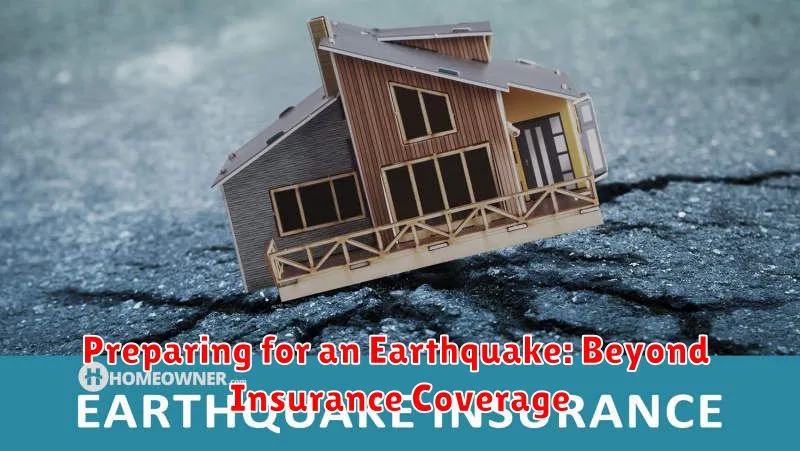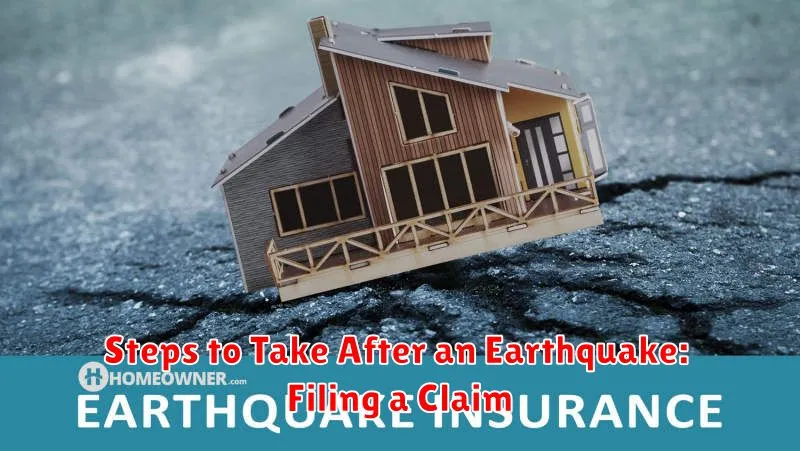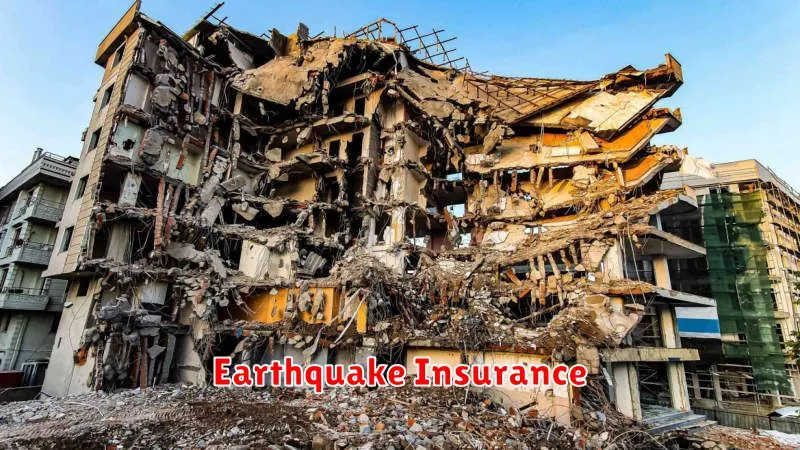Living in an earthquake-prone region comes with its own set of challenges, and protecting your biggest investment – your home – is paramount. Earthquake insurance can be a lifeline in the event of a devastating earthquake, providing financial assistance for repairs and rebuilding. However, navigating the complex world of earthquake insurance policies can be daunting. This comprehensive guide aims to demystify the process, equipping you with the knowledge and understanding to make informed decisions about your earthquake insurance.
From understanding the different types of policies to identifying the crucial coverage elements, we’ll delve into the essential aspects of earthquake insurance. We’ll explore the factors that influence premiums, highlight common pitfalls to avoid, and empower you to choose the policy that best suits your needs and budget. By the end of this guide, you’ll be equipped with the confidence to navigate the world of earthquake insurance and ensure your home is protected against Mother Nature’s unpredictable forces.
Understanding Earthquake Risk and Your Property’s Vulnerability
Earthquakes are a powerful force of nature that can cause significant damage to property and disrupt lives. While we can’t predict when or where an earthquake will occur, we can understand the risks and take steps to protect ourselves and our investments. This includes evaluating the vulnerability of our property to earthquake damage.
The vulnerability of your property depends on several factors, including:
- Location: Properties in seismically active areas are at a higher risk of experiencing earthquake damage.
- Soil Conditions: Soft or loose soils can amplify earthquake vibrations, increasing the risk of damage.
- Building Design and Construction: Older buildings or those built with less robust construction methods are more vulnerable to earthquake damage.
- Foundation Type: Unreinforced foundations can be susceptible to shifting and cracking during an earthquake.
Assessing the vulnerability of your property is crucial for understanding your earthquake risk. This can be done through a professional assessment by a licensed structural engineer. Understanding your risk allows you to take proactive measures to mitigate potential damage and protect your investment. These measures could include:
- Seismic Retrofitting: Strengthening your building’s structure to resist earthquake forces.
- Securing Heavy Objects: Anchoring heavy furniture and appliances to prevent them from falling during an earthquake.
- Earthquake Insurance: This policy provides financial protection against damage caused by earthquakes, helping you rebuild or repair your property after an event.
By understanding the earthquake risk and vulnerability of your property, you can make informed decisions to protect your investment and ensure your safety in the face of this powerful natural disaster.
The Basics of Earthquake Insurance Coverage
Earthquake insurance is a specialized type of coverage that protects your home and belongings from damage caused by seismic activity. It’s crucial to understand that standard homeowners insurance policies do not cover earthquake damage. Therefore, if you live in an earthquake-prone area, acquiring an earthquake insurance policy is essential.
Earthquake insurance policies typically cover damage to the following:
- Structure: This includes damage to the foundation, walls, roof, and other structural components of your home.
- Personal property: This covers damage to your belongings, such as furniture, appliances, electronics, and clothing.
- Living expenses: In case your home is uninhabitable due to earthquake damage, this coverage helps with temporary living expenses like hotel accommodations and meals.
It’s important to note that earthquake insurance coverage is usually subject to specific limits and deductibles. The deductible is the amount you pay out of pocket before your insurance coverage kicks in. You can choose your deductible amount, but keep in mind that a higher deductible generally leads to lower premiums.
Moreover, earthquake insurance policies typically come with limits on the amount of coverage available. This limit is the maximum amount your insurance company will pay for covered losses. Ensure you understand the limits of your policy and ensure they’re sufficient to cover your potential losses.
Before purchasing earthquake insurance, it’s essential to consider your specific situation and risk. Factors such as the location of your home, the age and construction of your structure, and the potential severity of earthquakes in your area all play a role in determining your need for and the cost of earthquake insurance.
Overall, earthquake insurance is a crucial component of comprehensive risk management for homeowners in earthquake-prone regions. By understanding the basics of coverage, limits, and deductibles, you can make informed decisions about protecting your home and your financial well-being.
What Does Earthquake Insurance Typically Cover?
Earthquake insurance is a specialized type of coverage that can help protect your home and belongings from damage caused by earthquakes. While the specific coverage can vary depending on your insurance provider and policy, earthquake insurance typically covers losses like:
- Damage to your home’s structure: This includes repairs to walls, floors, ceilings, roof, and foundation.
- Damage to personal belongings: This can include furniture, electronics, clothing, and other items inside your home.
- Additional living expenses: If your home is uninhabitable after an earthquake, earthquake insurance can cover temporary housing, food, and other essential expenses.
- Debris removal: This includes the cost of removing earthquake-related debris from your property.
It’s important to note that earthquake insurance typically doesn’t cover all types of losses. For example, it may not cover damage caused by landslides, mudslides, or tsunamis triggered by an earthquake. It’s crucial to review your policy carefully to understand what is and isn’t covered.
Before purchasing earthquake insurance, consider your risk level and the potential financial impact of an earthquake. Factors such as your location, proximity to fault lines, and the age and construction of your home can influence your risk.
Exclusions and Limitations of Earthquake Policies
While earthquake insurance can provide crucial financial protection in the event of a seismic event, it’s essential to understand its limitations and exclusions. These policies are designed to cover specific types of damage, and certain situations may not be covered. It’s important to carefully review the policy details and understand the following limitations:
Exclusions:
- Pre-existing damage: Policies generally won’t cover damage that existed before the earthquake occurred. This includes damage caused by settling, erosion, or prior earthquakes.
- Neglect or failure to maintain property: If the damage is a result of your negligence or failure to maintain the property, your claim may be denied.
- Flood damage: While earthquakes can cause tsunamis or flooding, most earthquake policies don’t cover flood damage. You’ll need separate flood insurance for that.
- Landslides and mudslides: Unless specifically included, these events may not be covered by earthquake insurance.
- Business Interruption: Earthquake policies typically cover physical damage but may not cover losses due to business interruption or lost income.
- Personal property: Some policies may only cover damage to the structure itself and not personal belongings. Check your policy details to ensure you have sufficient coverage for your valuables.
Limitations:
- Deductibles: Earthquake policies often have high deductibles, meaning you’ll need to pay a significant portion of the repair costs out of pocket.
- Coverage limits: There are usually limits on the maximum amount of coverage provided for earthquake damage. Ensure the limit is sufficient to cover your property’s value and rebuilding costs.
- Waiting periods: Some policies have waiting periods before coverage kicks in, meaning you won’t be covered immediately after purchasing the policy.
- Earthquake magnitude thresholds: Some policies may only cover damage caused by earthquakes exceeding a specific magnitude.
It’s crucial to discuss your specific needs and circumstances with your insurance agent to understand the limitations and exclusions of your policy. This will help ensure you have the appropriate coverage for your property and are prepared in the event of an earthquake.
Factors Affecting Earthquake Insurance Premiums
Earthquake insurance premiums are influenced by a variety of factors, ensuring that the cost of coverage accurately reflects the risk involved. Understanding these factors can help you make informed decisions about your insurance needs.
Location: Your home’s proximity to active fault lines is a primary determinant of premium. Areas with a higher risk of earthquakes naturally command higher premiums. For instance, regions along the San Andreas Fault in California will typically have significantly higher premiums than those located in areas with lower seismic activity.
Construction Type: The materials used in building your home play a crucial role. Homes built with earthquake-resistant materials like reinforced concrete and steel framing will generally receive lower premiums. Older structures lacking these features might attract higher premiums due to their vulnerability to earthquake damage.
Building Code Compliance: Homes constructed according to current building codes and seismic regulations are more likely to withstand earthquakes. Compliance with these standards can result in lower premiums compared to homes built before the implementation of such codes.
Deductible: Choosing a higher deductible for earthquake coverage can lead to lower premiums. However, remember that you’ll be responsible for covering the deductible amount out of pocket in case of an earthquake event. You should weigh the financial implications of a higher deductible against the potential savings in premiums.
Coverage Limits: The amount of coverage you choose for your home also affects your premiums. Higher coverage limits mean higher premiums, so it’s essential to determine the appropriate level of coverage for your needs and budget.
Previous Claims: If you have filed claims for earthquake damage in the past, your premiums might be higher. Insurance companies use this information to assess your risk profile and adjust your premiums accordingly.
Deductibles and How They Impact Your Coverage
Earthquake insurance policies, like most insurance policies, feature deductibles. A deductible is the amount of money you’ll pay out of pocket before your insurance company begins to cover your losses. For example, if your deductible is $1,000 and you experience $5,000 in damage to your home, you’d pay $1,000 and your insurer would cover the remaining $4,000.
The higher your deductible, the lower your premium will be. This is because you’re essentially taking on more of the risk yourself. On the other hand, a lower deductible will mean a higher premium. You’ll pay less out of pocket in the event of an earthquake, but you’ll pay more overall for your insurance.
When choosing your deductible, it’s important to consider your financial situation. If you can afford to cover a higher deductible, it might make sense to do so to lower your premium. However, if you’re on a tight budget, a lower deductible might be a better choice, even if it means paying more in premiums.
It’s also important to think about the potential cost of earthquake damage. If you live in an area with a high risk of earthquakes, a lower deductible may be a good idea. This will ensure you have more coverage if your home is severely damaged.
Government-Backed Earthquake Insurance Programs
While private insurance companies offer earthquake coverage, there are also government-backed programs designed to help homeowners in specific regions. These programs typically provide financial assistance or subsidized insurance premiums. The most notable examples include:
National Flood Insurance Program (NFIP): Although primarily focused on flood insurance, the NFIP also offers limited earthquake coverage in certain areas. This coverage is often available for properties located in regions designated as high-risk for both floods and earthquakes.
California Earthquake Authority (CEA): As a state-backed insurance program, the CEA offers affordable earthquake insurance to residents of California. It provides policies that cover damage to homes and belongings, as well as additional living expenses following an earthquake.
Earthquake Reinsurance Pool (ERP): This program, available in Washington state, serves as a reinsurance facility for private insurers. It helps insurers cover the costs of large earthquake claims, potentially leading to lower premiums for homeowners.
State-Specific Programs: Some other states have their own earthquake insurance programs, though they may be less comprehensive than those mentioned above. It’s crucial to research any potential programs available in your state.
These government-backed programs are designed to make earthquake insurance more accessible and affordable. However, it’s important to note that they often have specific eligibility criteria and coverage limitations. Before relying on these programs, thoroughly research their terms and conditions to ensure they align with your needs.
Evaluating Earthquake Insurance Quotes and Providers
Once you’ve decided to purchase earthquake insurance, the next step is to compare quotes and providers. This process is crucial to securing the best coverage at the most competitive price. Here’s a breakdown of key factors to consider when evaluating quotes and providers:
Coverage Limits: Compare the maximum amount of coverage each insurer offers for earthquake damage. This should be sufficient to rebuild your home and replace your belongings. Consider the replacement cost value (RCV) of your home, which is the cost to rebuild it using current materials and labor costs.
Deductibles: Deductibles are the out-of-pocket expenses you’ll pay before your insurance kicks in. Higher deductibles generally result in lower premiums. Choose a deductible that aligns with your budget and risk tolerance.
Exclusions: Pay close attention to the exclusions in the policy. Some common exclusions include damage to swimming pools, landscaping, and underground utilities. Make sure the coverage meets your specific needs.
Provider Reputation: Research the insurer’s financial stability, claims-paying history, and customer satisfaction ratings. Look for companies with a strong track record of handling earthquake claims fairly and efficiently.
Customer Service: Evaluate the insurer’s customer service channels, including online resources, phone support, and local agents. Choose a provider with responsive and helpful customer service to ensure a smooth claims process.
Additional Features: Some insurers offer additional features, such as coverage for earthquake-related business interruptions or coverage for personal belongings stored off-site. Consider whether these features are valuable for your situation.
Get Multiple Quotes: Don’t settle for the first quote you receive. Get quotes from several reputable insurers to compare prices and coverage options. Online comparison tools can simplify this process.
By diligently comparing quotes and providers, you can make an informed decision and secure the best possible earthquake insurance coverage for your investment.
Preparing for an Earthquake: Beyond Insurance Coverage

While earthquake insurance is a crucial part of protecting your investment, it’s not the only step you should take. Being prepared for an earthquake goes beyond financial security and requires a proactive approach to safeguarding your property and loved ones.
Beyond insurance, consider these important steps:
- Secure Your Home: Bolting heavy appliances and furniture to the walls, installing earthquake-resistant bracing in your garage, and reinforcing weak spots in your foundation can significantly minimize damage.
- Prepare an Emergency Kit: Keep a well-stocked emergency kit with essential supplies such as food, water, first-aid supplies, and a battery-powered radio. This will ensure you have access to crucial resources in the event of a power outage.
- Develop a Family Emergency Plan: Know where to meet after an earthquake and communicate with family members. Practice your plan regularly so everyone knows what to do in an emergency.
- Learn CPR and First Aid: Being trained in basic life-saving skills can make a critical difference in an earthquake disaster.
- Stay Informed: Be aware of your local earthquake risks and stay informed about any advisories or warnings from authorities.
Remember, earthquake insurance is a valuable tool, but it’s only one part of a comprehensive disaster preparedness strategy. By taking proactive steps to secure your home, prepare for emergencies, and stay informed, you can significantly increase your resilience and minimize the impact of an earthquake.
Steps to Take After an Earthquake: Filing a Claim

After experiencing the tremors of an earthquake, your immediate focus will be on ensuring your safety and checking on loved ones. Once the initial shock has passed, you can begin to assess the damage to your property and start the claims process with your earthquake insurance provider.
Here’s a comprehensive guide on the steps to take after an earthquake to ensure a smooth claims process:
1. Prioritize Safety and Secure Your Property
Your safety is paramount. Ensure you and your family are unharmed. If possible, take measures to secure your property from further damage. This might include covering broken windows, boarding up doors, or securing loose items.
2. Document the Damage
Thoroughly document the damage caused by the earthquake. Take detailed photographs and videos of every affected area, including the exterior, interior, and any damaged personal belongings. Note the date and time of the earthquake in your documentation.
3. Contact Your Insurance Company
Contact your insurance company as soon as possible to report the damage. They will provide you with instructions on how to file a claim. Have your policy details ready and be prepared to describe the damage.
4. Cooperate with Your Insurance Adjuster
An insurance adjuster will be assigned to your claim to assess the damage. Be prepared to provide them with access to your property and answer any questions. Be honest and transparent about the extent of the damage.
5. Keep Records
Keep detailed records of all communication with your insurance company, including dates, times, and the names of individuals you spoke with. Retain copies of all documentation, including your policy, repair estimates, and any receipts for expenses incurred.
6. Understand Your Coverage
Review your policy thoroughly to understand your coverage limitations, deductibles, and claim procedures. Familiarize yourself with the terms and conditions, especially concerning earthquake-related damages.
7. Be Patient and Persistent
The claims process can take time, especially after a significant earthquake. Be patient and persistent in your follow-up with the insurance company. Keep track of deadlines and maintain open communication to ensure your claim progresses smoothly.
Filing an insurance claim after an earthquake can be a stressful process. By following these steps, you can navigate the process effectively and secure the financial support you need to rebuild your life and property.

